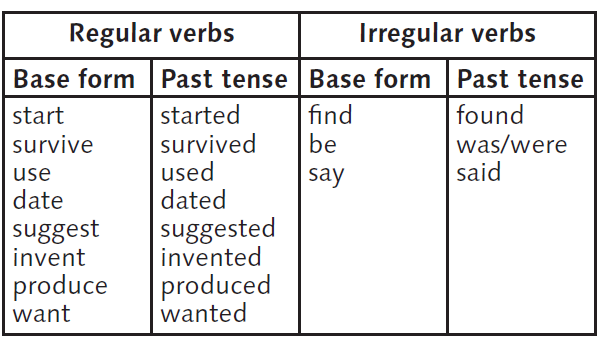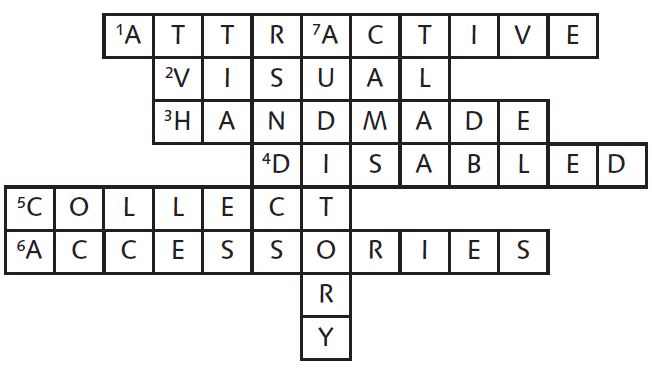Exercises of Activity Book
Starting out
1 Label each picture with the type of learner it represents. Then, match the following characteristics to each type.
- likes working on projects, drawing and doing things
- focuses on details
- likes talking and discussing rather than writing
- learns by doing
- learns through reading
- learns through listening
- finds it difficult to listen to long lectures
- is happy when he/she can practise what he/she is learning
- learns well when listening to lectures or music
Type of learner: 1
Visual learner; b e g
Type of learner: 2
Auditory learner; c f i
Type of learner: 3
Kinaesthetic learner; a d h
2 Choose the correct form of the verb.
Active learners (1) remember information when they (2) discuss it, (3) apply it or explain it to others.
A reflective learner (4) prefers to think about it quietly first.
When you are an active learner you (5) like group work, unlike a reflective learner.
However, taking notes (6) is hard for both, active and reflective learners, but it is harder for active learners.
3 Read each statement. Then. tick which student is most likely to use each learning technique.
Jameela: “I want to be a TV presenter in the future."
Ramzi: “I want to be a photographer in the future."
Mazen: “I want to be a firefighter in the future."
- takes part in discussions and dialogues Jameela
- needs to see people clearly when they speak Ramzi
- discusses his idea out loud Jameela
- learns by doing Mazen
- takes part in physical activities Mazen
- reads texts that are colourful Ramzi
4 Use these words to write complete questions and answer them. You should give two answers to each question: your own response and your partner's response.
- What do you do every afternoon?
- When do you visit your friends?
- Where do you go at weekends?
- When do you visit your grandparents?
- How often do you go to the theatre?
5 Use these notes to write a paragraph.
Noura is nine years old. She has got one sister, but no brothers. Her father is an engineer and her mother is a teacher. They live in a small flat, but Noura does not share her bedroom with her sister. She watches scientific documentaries sometimes, but her sister never does. Noura wants to start her own business in the future and design furniture.
6 Some of the information in exercise 5 is wrong. Listen to Noura's profile and write the five things that are incorrect.
- Noura has got one brother.
- Noura's mother isn't a teacher. She's a nurse.
- The family's flat isn't small; it's big.
- Noura shares her bedroom with her sister.
- Noura doesn't want to design furniture; she wants to design traditional clothes.
7 Complete the text with the verbs in the box below.
We don't know when people (1) started making rugs. However, in 1949, archaeologists (2) found the Pazyryk carpet inside a royal tomb. This carpet survived because it was frozen. It seems people (3) used it as a cover for a horse. Archaeologists said the rug dated from the 4th or 5th century BCE.
Some suggested that some people in Central Asia (4) invented carpets and produced small rugs. These people (5) wanted their rugs to be beautiful, but also useful. They used them to cover their floor, as wall hangings and curtains.
8 Complete these questions in the past tense. Then, answer them.
- When did people begin making rugs?
- Who found the Pazyryk carpet?
- Why did it survive?
- What did people use carpets for?
9 Write in the correct column the verbs in the past tense from the text in exercise 7 and give the base form.

10 Read this article about sand art bottles. Complete the sentences with the correct form of the verbs in brackets. Some verb forms might stay the same.
(1) Do you like traditional handicrafts? Here are some tips if you want to try to make sand art bottles at home:
- Get some sand. You can collect sand from the beach if there (2) is one nearby.
- You have to colour the sand. (3) get some coloured chalk and roll it across the sand. Or if you (4) live somewhere near Petra, you can find it in different colours.
- Put different layers of sand of different colours in a bottle. This (5) makes interesting designs.
- Push down on the sand until it is filled to the top. Close the bottle with a cap, or if you (6) don’t have one, put some glue on top and leave it to dry.
11 Read the phrases 1-6 and write words horizontally in the puzzle.
You are given the first letter.

- nice to look at ATTRACTIVE
- relating to seeing VISUAL
- made by people using their hands, not by a machine HANDMADE
- someone who can't use a part of their body properly DISABLED
- to keep objects because you think they are attractive COLLECT
- something such as a bag, belt or jewellery that you wear or carry ACCESSORIES
12 Read vertically the word for number 7. Write its clue.
- AUDITORY
Example answer; relating to hearing.
إعداد : شبكة منهاجي التعليمية
24 / 09 / 2023
النقاشات
Jood Sameeh
شكرا شكرا thank you
إضافة رد
0 ردود